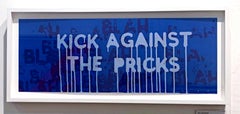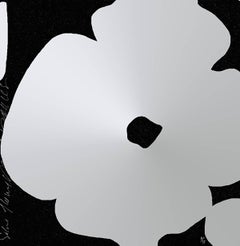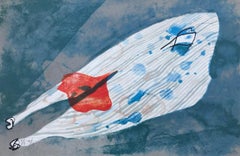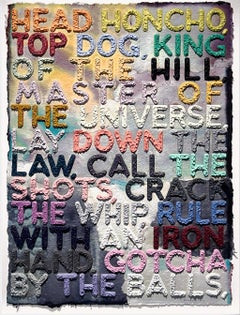Mel Bochner Figurative Prints
Mel Bochner experimented with a range of styles before finding his eventual success as a pioneer in Conceptual art. An audacious 1966 show at School of Visual Arts (SVA) in Manhattan that he presented, “Working Drawings and Other Visible Things on Paper Not Necessarily Meant to Be Viewed as Art,” remains a seminal touchstone for Conceptualism.
Bochner was born to a Pittsburgh sign painter in 1940. While attending the Carnegie Institute of Technology (now Carnegie Mellon) in the late 1950s, he studied color theory and modernist movements as well as classical drawing, a balance that was formative in his career. After graduation, he moved to San Francisco, creating paintings influenced by Clyfford Still and Jean Dubuffet.
It wasn’t until Bochner “found his way out of the labyrinth of late Abstract Expressionism,” as he put it to The Brooklyn Rail, that he began to create his most meaningful work. Following a stint auditing philosophy classes after a friend introduced him to the work of Heidegger, Bochner relocated to New York, finding work as a guard at the Jewish Museum. In Manhattan, he ran in the same circles as Dan Flavin, Brice Marden and Donald Judd.
“One of the conversations going on in New York in the late ’60s was about the relationship of the object to the art experience,” Bochner said. “...Younger artists like myself were talking about what it would mean to eliminate the object altogether.” This idea would become the foundation of the Conceptual movement, in which Bochner was instrumental. The artist is probably best known for his text-focused paintings, including a series that plays with the phrase “Blah Blah Blah.” He produces work that regards art as an experience, rather than an object, centering on the process of creation and viewership as opposed to the finished product.
Bochner’s “Working Drawings and Other Visible Things on Paper Not Necessarily Meant to Be Viewed as Art” featured drawings, notes and outlines from the likes of Milton Glaser, Carl Andre, Sol LeWitt and others as well as pages from Scientific American. Bochner, then an art history professor at SVA, photocopied the assemblage of works, added them to binders and positioned them on pedestals for the exhibition because the show’s organizers lacked the funds to frame the pieces.
Bochner’s works can be found in the collections of many major museums, including the Museum of Modern Art, the Metropolitan Museum of Art and the Whitney Museum of American Art.
Find original Mel Bochner prints and other art on 1stDibs.
2010s Contemporary Mel Bochner Figurative Prints
Screen
21st Century and Contemporary Contemporary Mel Bochner Figurative Prints
Screen
Early 2000s Contemporary Mel Bochner Figurative Prints
Ink, Screen
2010s Contemporary Mel Bochner Figurative Prints
Varnish, Color, Giclée, Screen
1990s Contemporary Mel Bochner Figurative Prints
Paper, Ink, Screen
2010s Contemporary Mel Bochner Figurative Prints
Screen
2010s Contemporary Mel Bochner Figurative Prints
Screen
1990s Contemporary Mel Bochner Figurative Prints
Screen, Ink
21st Century and Contemporary Contemporary Mel Bochner Figurative Prints
Screen
2010s Contemporary Mel Bochner Figurative Prints
Paper, Screen
2010s Contemporary Mel Bochner Figurative Prints
Screen
2010s Contemporary Mel Bochner Figurative Prints
Gold Leaf
1980s Contemporary Mel Bochner Figurative Prints
Screen
2010s Conceptual Mel Bochner Figurative Prints
Oil, Handmade Paper, Engraving, Monoprint
2010s Conceptual Mel Bochner Figurative Prints
Oil, Handmade Paper, Engraving, Monotype
2010s Conceptual Mel Bochner Figurative Prints
Oil, Handmade Paper, Engraving, Monoprint
2010s Conceptual Mel Bochner Figurative Prints
Oil, Engraving, Monoprint
1990s Contemporary Mel Bochner Figurative Prints
Woodcut




